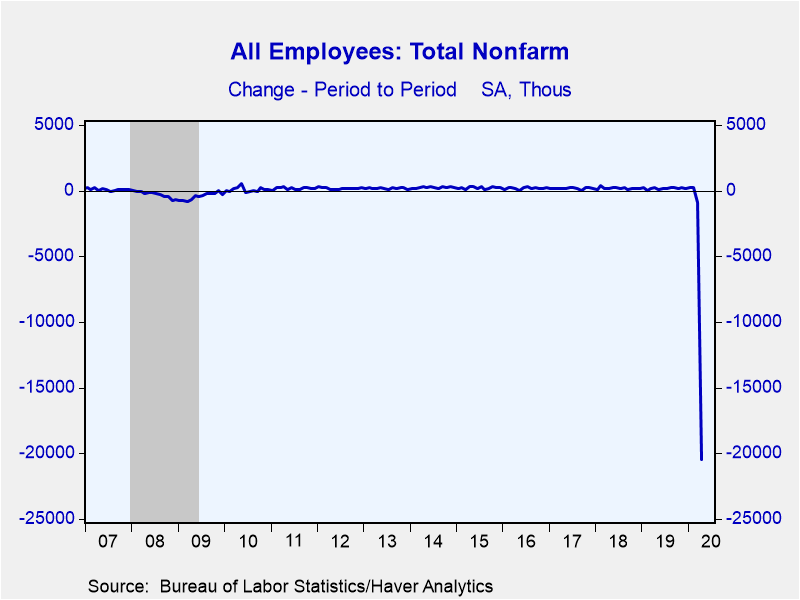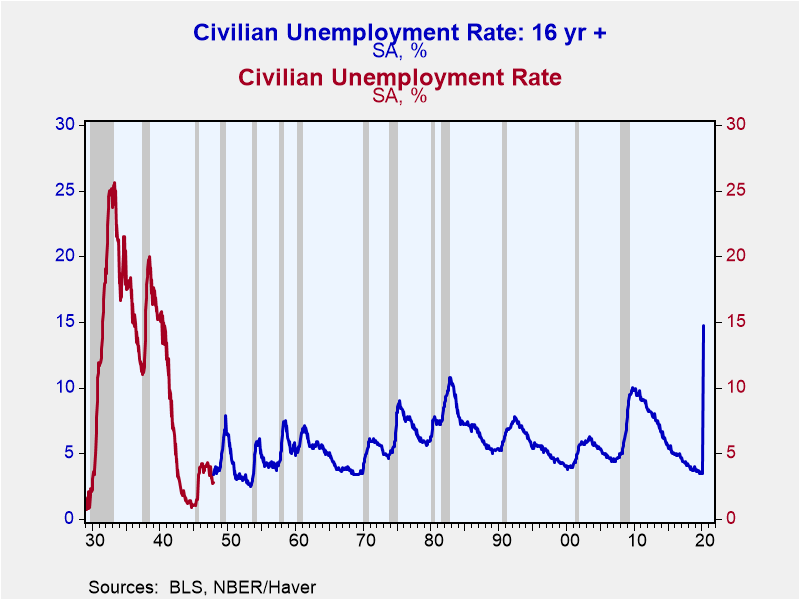 Global| May 08 2020
Global| May 08 2020U.S. Nonfarm Payroll Declines Record 20.5 Million; Unemployment Rate Sets Post-War High
by:Tom Moeller
|in:Economy in Brief
Summary
• Labor market collapses as coronavirus takes hold. • Jobless rate surges to 1948 high. • Lower paid workers bare bulk of job cuts. Nonfarm payroll employment declined a record 20.500 million during April (-12.9% y/y) following an [...]
• Labor market collapses as coronavirus takes hold.
• Jobless rate surges to 1948 high.
• Lower paid workers bare bulk of job cuts.
Nonfarm payroll employment declined a record 20.500 million during April (-12.9% y/y) following an 870,000 March decline, revised from -710,000. A 22.750 million fall had been expected in the Action Economics Forecast Survey. As in March, private service-producing industry employment was notably hard hit, declining 17.165 million.
The unemployment rate jumped to a record 14.7%. A rise to 16.8% had been expected. Employment in the household survey weakened 22.369 million while the labor force declined 6.432 million. The overall jobless rate, including those who were marginally attached or working part-time for economic reasons, increased to 22.8%. As a basis of comparison, the National Bureau of Economic Research estimates that the unemployment rate stood at 14.76% in October 1940.
Average hourly earnings in the private sector surged 4.7% (7.9% y/y). A 0.4% gain had been expected. The large increase reflects a disproportionate share of job loss amongst lower paid workers.
Like last month, the current labor market figures are taken from a survey conducted three weeks before today's report. Therefore, they may understate recent layoff activity due to business shutdowns.
The labor market data are contained in Haver's USECON database. Detailed figures are in the EMPL and LABOR databases. The expectations figures are in the AS1REPNA database.
COVID-19: Which Workers Will Be Most Impacted? from the Federal Reserve Bank of Philadelphia can be found here.
| Employment: (SA, M/M Change, 000s) | Apr | Mar | Feb | Apr Y/Y | 2019 | 2018 | 2017 |
|---|---|---|---|---|---|---|---|
| Payroll Employment | -20,500 | -870 | 230 | -12.9% | 1.4% | 1.6% | 1.6% |
| Previous Estimate | -- | -701 | 275 | -- | -- | -- | -- |
| Manufacturing | -1,330 | -34 | 8 | -10.5 | 1.2 | 2.0 | 0.7 |
| Construction | -975 | -33 | 46 | -11.3 | 2.8 | 4.6 | 3.6 |
| Private Service-Producing | -17,165 | -768 | 143 | -15.3 | 1.4 | 1.5 | 1.8 |
| Government | -980 | -28 | 31 | -3.6 | 0.6 | 0.5 | 0.4 |
| Average Weekly Hours - Private Sector | 34.2 | 34.1 | 34.4 | 34.4 | 34.4 | 34.5 | 34.4 |
| Private Sector Average Hourly Earnings (%) | 4.7 | 0.5 | 0.3 | 7.9 | 3.3 | 3.0 | 2.6 |
| Unemployment Rate (%) | 14.7 | 4.4 | 3.5 | 3.6 | 3.7 | 3.9 | 4.3 |
Tom Moeller
AuthorMore in Author Profile »Prior to joining Haver Analytics in 2000, Mr. Moeller worked as the Economist at Chancellor Capital Management from 1985 to 1999. There, he developed comprehensive economic forecasts and interpreted economic data for equity and fixed income portfolio managers. Also at Chancellor, Mr. Moeller worked as an equity analyst and was responsible for researching and rating companies in the economically sensitive automobile and housing industries for investment in Chancellor’s equity portfolio. Prior to joining Chancellor, Mr. Moeller was an Economist at Citibank from 1979 to 1984. He also analyzed pricing behavior in the metals industry for the Council on Wage and Price Stability in Washington, D.C. In 1999, Mr. Moeller received the award for most accurate forecast from the Forecasters' Club of New York. From 1990 to 1992 he was President of the New York Association for Business Economists. Mr. Moeller earned an M.B.A. in Finance from Fordham University, where he graduated in 1987. He holds a Bachelor of Arts in Economics from George Washington University.








